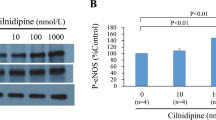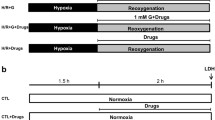Summary
Rat neonatal myocytes exposed to 2.5 mM CaCN and 20 mM 2-deoxyglucose at pH 6.2 (chemical hypoxia) quickly lose viability when pH is increased to 7.4, with or without washout of inhibitors — a ‘pH paradox’. In this study, we evaluated the effect of two Na+/H+ exchange inhibitors (dimethylamiloride and HOE694) and a Na+/Ca2+ exchange inhibitor (dichlorobenzamil) on pH-dependent reperfusion injury. Intracellular free Ca2+ and electrical potential were monitored by laser scanning confocal microscopy of rat neonatal cardiac myocytes grown on coverslips and co-loaded with Fluo-3 and tetramethylrhodamine methylester. After 30–60 min of chemical hypoxia at pH 6.2, mitochondria depolarized and Ca2+ began to increase uniformly throughout the cell. Free Ca2+ reached levels estimated to exceed 2 μM by 4h. Washout of inhibitors at pH 7.4 (reperfusion), with or without dichlorobenzamil, killed most cells within 60 min, despite a marked reduction of Ca2+ in dichloroben zamil-treated cells. Reperfusion at pH 7.4 in the presence of 75 μM dimethylamiloride or 20 μM HOE694, or at pH 6.2, prevented cell death. HOE694-treated cells placed into culture medium recovered mitochondrial membrane potential. In most cells, this occurred before normal Ca2+ was restored. Contracted myocytes re-extended over a 24-h-period. By 48 hours, most cells contracted spontaneously and showed normal Ca2+ transients. Our results indicate that Na+/H+ exchange inhibition protects against pH-dependent reperfusion injury and facilitates full recovery of cell function.
Similar content being viewed by others

Abbreviations
- DCB:
-
dichlorobenzamil
- DMA:
-
dimethylamiloride
- 2-DOG:
-
2-deoxy-D-glucose
- HOE694:
-
3-methylsulfonyl-4-piperidinobenzoyl guanidine hydrochloride
- KRH:
-
Krebs-Ringer-HEPES buffer containing 115 mM NaCl, 5 mM KCl, 1 mM KH2PO4, 1,2 mM MgSO4, 2 mM CaCl2, and 25 mM Na-HEPES buffer
- PI:
-
propidium iodide
- TMRM:
-
tetramethylrhodamine methylester
- ΔΨ:
-
electrical potential difference
- Ψ:
-
electric potential
References
Anderson SE, Murphy E, Steenbergen C, London RE, Cala PM (1990) Na−H exchange in myocardium: effects of hypoxia and acidification on Na and Ca. Am J Physiol 259:C940-C948
Bergmeyer HU (1974) Methods of Enzymatic Analysis. 3rd ed, Verlag Chemie Weinheim
Bond JM, Chacon E, Herman B, Lemasters JJ (1993) Intracellular pH and calcium homeostasis during the pH paradox of reperfusion injury to cultured neonatal rat cardiac myocytes. Am J Physiol 265:C129-C137
Bond JM, Herman B, Lemasters JJ (1991) Protection by acidotic pH against anoxia/reoxygenation injury to rat neonatal crdiac myocytes. Biochem Biophys Res Commun 179:798–803
Bond JM, Herman B, Lemasters JJ (1991) Recovery of cultured rat neonatal myocytes from hypercontracture after chemical hypoxia. Res Comm Chem Pathol Pharmacol 71(2):195–208
Caldwell-Kenkel JC, Currin RT, Thurman RG, Lemasters JJ (1989) Damage to endothelial cells after reperfusion of rat livers stored for 24 hours: protection by mildly acidic pH and lack of protection by antioxidants. FASEB J 3:A625
Chacon E, Reece JM, Nieminen A-L, Zahrebelski G, Herman B, Lemasters JJ (1993) Distribution of electrical potential, pH, free Ca2+, and cell volume inside cultured adult rabbit cardiac myocytes during chemical hypoxia: a multiparameter digitized confocal microscopic study. Submitted to Biophysical Journal
Currin RT, Gores GJ, Thurman RG, Lemasters JJ (1991) Protection by acidotic pH against anoxic cell killing in perfused rat liver: evidence for a “pH paradox”. FASEB J 5:207–210
Currin RT, Toole JG, Thurman RG, Lemasters JJ (1990) Evidence that Carolina rinse solution protects sinusoidal endothelial cells against reperfusion injury after cold ischemic storage of rat liver. Transplantation 50:1076–1078
Denton RM, McCormack JG (1990) Ca2+ as a second messenger within mitochondria of the heart and other tissues. Ann Rev Physiol 52:451–466
Gores GJ, Nieminen A-L, Fleishman KE, Dawson TL, Herman B, Lemasters JJ (1988) Extracellular acidosis delays onset of cell death in ATP-depleted hepatocytes. Am J Physiol 255:C315-C322
Gores GJ, Nieminen A-L, Wray BE, Herman B, Lemasters JJ (1989) Intracellular pH during “chemical hypoxia” in cultured hepatocytes. J Clin Invest 83:386–396
Grinwald PM (1982) Calcium uptake during post-ischemic reperfusion in the isolated rat heart: influence of extracellular sodium. J Mol Cell Cardiol 14:359–365
Haigney MCP, Miyata H, Lakatta EG, Stern MD, Silverman HS (1992) Dependence of hypoxic cellular calcium loading on Na+−Ca2+ exchange. Circ Res 72:547–557
Harper IS, Bond JM, Chacon E, Reece JM, Herman B, Lemasters JJ (1993) Inhibition of Na+/H+ exchange preserves viability, restores mechanical function, and prevents the pH paradox in reperfusion injury to cultured rat neonatal myocytes. FASEB J 7:A94
Haworth RA, Goknur AB (1992) ATP dependence of calcium uptake by the Na−Ca exchanger of adult heart cells. Circ Res 71:210–217
Hearse DJ, Bullock GR (1978) The oxygen paradox and the calcium paradox: two faces of the same problem? J Mol Cell Cardiol 10:641–668
Jennings RB, Reimer K, Steenbergen C (1988) Complete global myocardial ischemia in dogs. Crit Care Med 16:988–996
Kaplan SH, Gilliam DM, Lemasters JJ, Cascio WE (1991) Respiratory acidosis and dimethyl amiloride attenuate reperfusion injury in isolated arterially perfused rabbit papillary muscle. Circulation 84:II-665
Lemasters JJ, Chacon E, Zahrebelski G, Reece JM, Nieminen A-L (1993) Laser scanning confocal microscopy of living cells. In B Herman, Lemasters JJ (eds) Academic Press, New York, pp 339–354
Lemasters JJ, DiGuiseppi J, Nieminen A-L, Herman B (1987) Blebbing, free Ca++ and mitochondrial membrane potential preceding cell death in hepatocytes. Nature 325:78–81
Lemasters JJ, Nieminen A-L, Gores GJ, Dawson TL, Wray BE, Kawanishi T, Tanaka Y, Florine-Casteel K, Bond JM, Herman B (1990) Multiparameter digitized video microscopy (MDVM) of hypoxic cell injury. In: Herman B, Jacobson K (eds) Optical Microscopy for Biology Alan R Liss, Inc, New York, pp 523–542
Malgaroli A, Milani D, Meldolesi J, Pozzan T (1987) Fura-2 measurement of cytosolic free Ca2+ in monolayers and suspensions of various types of animal cells. J Cell Biol 105:2145–2155
Marban E, Koretsune Y, Corretti M, Chacko VP, Kusuoka H (1989) Calcium and its role in myocardial cell injury during ischemia and reperfusion. Circulation 80 (Suppl IV):IV-17–IV-22
Meng H-P, Lonsberry BB, Pierce GN (1991) Influence of perfusate pH on the postischemic recovery of cardiac contractile function: involvement of sodium-hydrogen exchange. J Pharmacol Exp Ther 258:772–777
Miyata H, Lakatta EG, Stern MD, Silverman HS (1992) Relation of mitochondrial and cytosolic free calcium to cardiac myocyte recovery after exposure to anoxia. Circ Res 71:605–613
Murphy E, Perlman M, London RE, Steenbergen C (1991) Amiloride delays the ischemia-induced rise in cytosolic free calcium. Circ Res 68:1250–1258
Nayler WG, Panagiotopoulos S, Elz JS, Daly MJ (1988) Calcium-mediated damage during post-ischaemic reperfusion. J Mol Cell Cardiol 20 (Suppl II):41–54
Piper HM (1989) Energy deficiency, calcium overload or oxidative stress: possible causes of irreversible ischemic myocardial injury. Klin Wochenschr 67:465–476
Sanchez-Urdazpal L, Gores GJ, Lemasters JJ, Thurman RG, Steers JL, Wahlstrom HE, Hay EI, Porayko MK, Wiesner RH, Krom RAF (1993) Carolina rinse solution decreases liver injury during clinical liver transplantation. Transplant Proc 25:1574–1575
Schmid A, Scholz W, Lang HJ, Popp R (1992) Na+/H+ exchange in porcine cerebral capillary endothelial cells is inhibited by a benzoylguanidine derivative. Biochem Biophys Res Commun 184:112–117
Siegl PKS, Cragoe EJ, Trumble MJ, Kaczorowski EJ (1984) Inhibition of Na/Ca exchange in membrane vesicles and papillary muscle preparations from guinea pig heart by analogues of amiloride. Proc Natl. Acad Sci USA 81:3238–2342
Siegmund B, Zude R, Piper HM (1992) Recovery of anoxic-reoxygenated cardiomyocytes from severe Ca2+ overload. Am J Physiol 263:H1262-H1269
Stern MD, Chien AM, Capogrossi MC, Pelto DJ, Lakatta EG (1985) Direct observation of the “oxygen paradox” in single rat ventricular myocytes. Circ Res 56:899–903
Tani M, Neely JR (1989) Role of intracellular Na in Ca overload and depressed recovery of ventricular function of reperfused ischemic rat hearts. Circ Res 65:1045–1056
Tani M, Neely JR (1990) Na+ accumulation increases Ca2+ overload and impairs function in anoxic rat heart. J Mol Cell Cardiol 22:57–72
Thandroyen FT, Bellotto D, Katayama A, Hagler HK, Willerson JT, Buja LM (1992) Subcellular electrolyte alterations during progressive hypoxia and following reoxygenation in isolated neonatal rat ventricular myocytes. Circ Res 71:106–119
Author information
Authors and Affiliations
Additional information
This work was supported, in part, by Grant N00014-89-J-1433 from the Office of Naval Research and Grants AG07218 an DK37034 from the National Institutes of Health. I.S.H. was the recipient of a Post-Doctoral Scholarship from the Medical Research Council of South Africa. A preliminary report of portions of this work was presented at Experimental Biology '93, New Orleans, March 28–April 1, 1993 (15)
Rights and permissions
About this article
Cite this article
Harper, I.S., Bond, J.M., Chacon, E. et al. Inhibition of Na+/H+ exchange preserves viability, restores mechanical function, and prevents the pH paradox in reperfusion injury to rat neonatal myocytes. Basic Res Cardiol 88, 430–442 (1993). https://doi.org/10.1007/BF00795410
Received:
Accepted:
Issue Date:
DOI: https://doi.org/10.1007/BF00795410



